Bristol
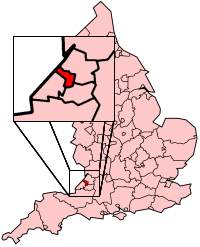
Bristol's Location within England |
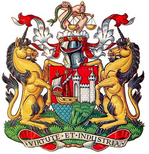
Bristol's Coat of Arms |
Bristol
is an English
city and county
and one of the three administrative centres of South West England (the
others being Plymouth
and Exeter).
From its earliest days, its prosperity has been linked to that of the
Port of Bristol, the commercial port which originated in the city centre,
but which has now moved to the Bristol Channel coast at Avonmouth
and Portbury.
Bristol
is England's eighth, and the United Kingdom's eleventh, most populous
city. As such, it is one of England's core cities. For half a millennium
Bristol
had been the second largest English city after London,
until the rapid rise of Liverpool,
Manchester
and Birmingham,
in the 1780s.
| Geography |
| Status |
Ceremonial county,
City and Unitary district |
| Region |
South West England
|
Area
- Total
- District |
Ranked 47th
110 km²
Ranked 237th |
| Admin HQ |
Bristol
|
| ISO 3166-2 |
GB-BST |
| ONS code |
00HB |
| Traditional county |
County corporate
(Gloucestershire
and Somerset) |
| OS grid reference |
ST5946972550
|
| Coordinates |
51°27N 2°35W
|
| NUTS 3 |
UKK11 |
| Demographics |
Population
- Total (2003 est.)
- Density
- District
|
Ranked 43rd
391,525
3,577 / km²
Ranked 7th |
| Ethnicity |
91.8% White
2.9% S. Asian
2.3% Afro-Caribbean |
| Politics
|
| Members of Parliament
|
Roger Berry
Kerry McCarthy
Doug Naysmith
Dawn Primarolo
Stephen Williams |
Local Government
The Avon traditionally
marks the border between gloucestershire
and Somerset. In
1373 Edward III of England proclaimed "that the said town of Bristol
withall be a County by itself and called the county of Bristol for ever",
but maps usually show it as part of Gloucestershire,
and as the city spilled south of the river, it took the county with it.
In 1974 Bristol
became a district of the newly formed administrative County of Avon. When
that county was abolished on the 1st April 1996, Bristol
returned to its former status of a city and county in itself. The city
borders on the unitary districts of Bath and North East Somerset, North
Somerset and South Gloucestershire.
History
The town of Brycgstow
(Old English, "the place at the bridge") was in existence by
the beginning of the 11th Century, and under Norman rule acquired one
of the strongest castles in southern England. The River Avon in the city
centre has slowly evolved into Bristol Harbour, and since the 12th Century
the harbour has been an important port, handling much of England's trade
with Ireland. In 1247 a new bridge was built and the town was extended
to incorporate neighbouring suburbs, becoming in 1373 a county in its
own right. During this period Bristol also became a centre of shipbuilding
and manufacturing.
By the 14th Century
Bristol
was England's third-largest town (after London
and York),
with perhaps 15-20,000 inhabitants on the eve of the Black Death of 1348-49.
The plague inflicted a prolonged pause in the population growth of Bristol,
with numbers remaining at 10-12,000 through most of the 15th and 16th
Centuries. Bristol
was made a city in 1542, with the former Abbey of St Augustine becoming
Bristol Cathedral. During the Civil War the city suffered (1643-45) through
Royalist military occupation and plague.
In 1497 Bristol
was the starting point for John Cabot's voyage of exploration to North
America.
Renewed growth came
with the 17th Century rise of England's American colonies and the rapid
18th Century expansion of England's part in the Atlantic trade in Africans
taken for slavery in the Americas.
Bristol,
along with Liverpool,
became a significant centre for the slave trade although few slaves were
brought to Britain. During the height of the slave trade, from 1700 to
1807, more than 2000 slaving ships were fitted out at Bristol,
carrying a (conservatively) estimated half a million people from Africa
to the Americas and slavery.
Competition from Liverpool
from c.1760, the disruption of maritime commerce through war with France
(1793) and the abolition of the slave trade (1807) contributed to the
city's failure to keep pace with the newer manufacturing centres of the
north and midlands. The long passage up the heavily tidal Avon Gorge,
which had made the port highly secure during the middle ages, had become
a liability which the construction of a new "Floating Harbour"
(designed by William Jessop) in 1804-9 failed to overcome. Nevertheless,
Bristol's population (66,000 in 1801) quintupled during the 19th Century,
supported by new industries and growing commerce. It was particularly
associated with the leading engineer Isambard Kingdom Brunel, who designed
the Great Western Railway between Bristol
and London,
two pioneering Bristol-built steamships, and the Clifton Suspension Bridge.
Bristol's city centre
suffered severe damage from bombing during World War II. The original
central area, near the bridge and castle, is still a park featuring two
bombed out churches and some tiny fragments of the castle. (A third bombed
church has a new lease of life as St Nicholas' Church Museum.) Slightly
to the North, the Broadmead shopping centre was built over bomb-damaged
areas.
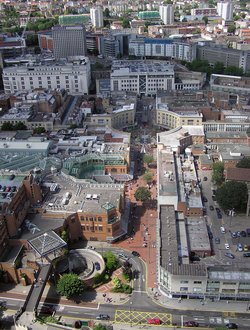
Looking across the Broadmead Shopping Centre from a static balloon at
500 feet
The removal of the
docks to Avonmouth, seven miles (11
km) downstream from the city centre, relieved congestion in the central
zone and allowed substantial redevelopment of the old central dock area
(the "Floating Harbour") in recent decades, although at one
time the continued existence of the docks was in jeopardy as it was seen
merely as derelict industry rather than a potential asset.
On March 4, 2005,
Bristol was granted Fairtrade City
status.
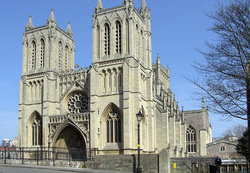
The west front of Bristol Cathedral |
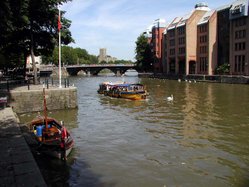
Bristol Bridge seen across the Harbour |
Aeronautics
In the 20th century,
Bristol's manufacturing activities expanded to include aircraft production
at Filton,
six miles (10 km) north of the city centre, by the Bristol Aeroplane Company,
and aero-engine manufacture by Bristol Aero Engines (later Rolls-Royce)
at Patchway.
The aeroplane company became famous for the WWI Bristol Fighter, and Second
World War Blenheim and Beaufighter aircraft. In the 1950s it became one
of the country's major manufacturers of civil aircraft, with the Bristol
Freighter and Britannia and the huge Brabazon airliner.
In the 1960s Filton
played a key role in the Anglo-French Concorde supersonic airliner project.
Concorde components were manufactured in British and French factories
and shipped to the two final assembly plants by road, sea and air. The
French assembly lines were in Toulouse in southern France with the British
lines in Filton. Luckily the very large
three-bay hangar built for the Bristol Brabazon was available for Concorde
production.
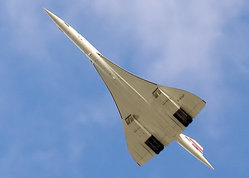
The last ever flight of any Concorde, 26 November 2003.
The aircraft is seen a few minutes before landing on the Filton runway
from which she first flew in 1979.
The French manufactured
the centre fuselage and centre wing and the British the nose, rear fuselage,
fin and wingtips. The largest proportion of the British share of the work
was the powerplant, the Rolls-Royce/Snecma 593. The engine's manufacture
was split between British Aircraft Corporation, Rolls-Royce (Filton)
and SNECMA at Villaroche near Paris.
The British Concorde
prototype G-BSST made its 22 minute maiden flight from Filton
to RAF Fairford on 9 April 1969, the French prototype F-WTSS had flown
from Toulouse five weeks earlier. Most of the employees of BAC and Rolls
Royce, plus a huge crowd, watched from around the airfield. Fairford was
chosen as the test airfield for Concorde because the runway at Filton
was rejected for test flying, its length was inadequate and there were
problems with the slope, and the first 1000 feet (300 m) of the runway
at its eastern (A38) end could not be used. However, from the end of 1977,
all test flying on the second production aircraft G-BBDG was done from
Filton, following the closure of the
BAC Fairford test base.
In 2003 the two airlines
using Concorde (British Airways and Air France) and the company supplying
spares and support (Airbus) made the decision to cease flying the aircraft
and to retire them to locations (mostly museums) around the world.
On 26 November 2003,
Concorde 216 (G-BOAF) made the final ever Concorde flight, returning to
Filton airfield to be kept there permanently as the centrepiece of a projected
air museum. This museum will include the existing Bristol Aero Collection
which is currently kept in a hangar at Kemble Airfield, forty miles (60
km) from Filton. This collection includes
a Bristol Britannia aircraft.
The major aeronautical
companies in Bristol now are BAE Systems, Airbus
and Rolls-Royce, both based at Filton.
Another important
aeronautical company in the city is Cameron Balloons, the world's largest
manufacturer of hot air balloons. Annually, in August, the city is host
to the Bristol International Balloon Fiesta, one of Europe's largest hot
air balloon events.
Bristol Cars
The Bristol Aeroplane
Company diversified into car manufacturing in the 1940s, building luxury
hand-built cars at their factory in Filton.
The car manufacturer became independent from the Bristol Aeroplane Company
in 1960.
Arts, Leisure and Media
The city has two significant
football clubs: Bristol City F.C. who play in Football League One and
Bristol Rovers F.C. who play in Football League Two. The city is also
home to a Rugby Union club known as Bristol Rugby, who have won promotion
to the Guinness Premiership, and a first-class cricket side, Gloucestershire
C.C.C.

In summer the grounds
of Ashton Court to the west of the city play host to the Bristol Balloon
Fiesta, a major event for hot-air ballooning in Britain. The Fiesta draws
a substantial crowd even for the early morning lift that typically begins
at about 6.30 am and a fairground atmosphere is sustained throughout the
day. A second mass ascent is normally scheduled for the early evening,
again taking advantage of lower wind speeds.
Ashton Court also
plays host to the Ashton Court festival each summer, an outdoors music
festival which used to be known as the Bristol Community Festival.
The city's principal
theatre company, the Bristol Old Vic, was founded in 1946 as an offshoot
of the Old Vic company in London. Its
premises on King Street consist of the 1766 Theatre Royal (400 seats),
a modern studio theatre called the New Vic (150 seats), and foyer and
bar areas in the adjacent Coopers' Hall (built 1743). The Theatre Royal
is a grade I listed building and the oldest continuously-operating theatre
in England. The Bristol Old
Vic also runs a prominent Theatre School. The Bristol Hippodrome is a
larger theatre (1981 seats) which hosts national touring productions,
while the 2000-seat Colston Hall, named after Edward Colston, is the city's
main concert venue.
The music scene is
thriving and significant. From the late 1970's onwards it was home to
a crop of cultish bands combining punk, funk, dub and political consciousness,
the most celebrated being The Pop Group. Ten years later, Bristol
was the birthplace of a type of English hip-hop music called trip hop
or the Bristol Sound, epitomised in the work of artists such as Tricky,
Portishead, Smith & Mighty and Massive Attack. It is also a stronghold
of drum n bass with notable bands like the Mercury Prize winning Roni
Size/Reprazent and the woefully cynical Kosheen as well as the pioneering
likes of DJ Krust and More Rockers. This music is part of the wider Bristol
Urban Culture scene which received huge international media attention
in the 1990s and still thrives under the radar today.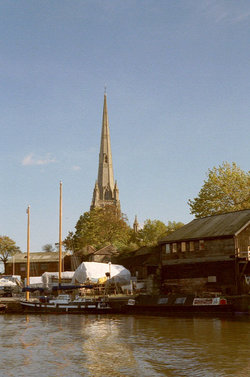
Bristol's fiercely
independent, pioneering spirit continues and in the early 21st Century
is home to one of the largest and most diverse DIY music communities in
the UK. Artists such as Gravenhurst and Chikinki have revived popular
interest over the past few years while a crop of highly influential cult
acts such as Wall Planner, Pricktaster and November's ashes in rain continue
to inspire a kind of smug civic pride. A dynamic community of bands, artists,
promoters and music fans has developed around the Choke forum, named after
a popular fanzine and club night which has championed underground music
from Bristol and beyond since 2001.
Bristol
is home to many live music venues, of which The Old Duke is perhaps the
best known. Internationally recognised jazz and blues musicians active
in Bristol include Eddie Martin, Jim
Blomfield and Andy Sheppard.
The Bristol City Museum
and Art Gallery houses a collection of natural history, archaeology, local
glassware, Chinese ceramics and art. The Bristol Industrial Museum, on
the dockside, shows local industrial heritage and operates a steam railway,
boat trips, and working dockside cranes. The City Museum also runs three
preserved historic houses: the Tudor Red Lodge, the Georgian House, and
Blaise Castle House. The Watershed media centre and Arnolfini gallery,
both in disused dockside warehouses, exhibit contemporary art, photography
and cinema.
Stop frame animation
films and commercials painstakingly produced by Aardman Animations and
high quality television series focusing on the natural world have also
brought fame and artistic credit to the city. Bristol
is where the British Broadcasting Corporation (BBC) has its regional headquarters,
and Natural History Unit. Bristol is
also the birthplace of the actor Cary Grant.
Bristol
is the home of a regional morning newspaper, the Western Daily Press,
a local evening paper, the Evening Post and a weekly free newspaper, the
Bristol Observer. A Bristol edition of Metro is distributed for free on
buses in the area. The local listings magazine, Venue, is now published
weekly after many years as a fortnightly publication and comprehensively
covers the city's music, theatre and arts scenes. The Spark magazine (Since
1993) covers the surging interest in all things green, ethical and New
Age. Bristol indymedia is a resource for Bristols anarchist and activist
community and is the sixth largest website associated with the city.
Education
Bristol
is home to two major institutions of higher education: the University
of Bristol, a "redbrick" chartered in 1909, and the University
of the West of England, formerly Bristol Polytechnic, which gained university
status in 1992. The city also has two dedicated further education institutions,
City of Bristol College and Filton College as well as a theological college,
Trinity College, Bristol. The Create centre is home to many sustainable
development projects and life long learning schemes. It has 129 primary
schools and three city learning centres.
Transport
There are two principal
railway stations in Bristol: Bristol
Parkway and Bristol Temple Meads. Bristol
was never well served by suburban railways, though the Severn Beach Line
to Avonmouth and Severn
Beach survived the Beeching Axe and is still in operation today. The
Portishead Railway was closed in the Beeching Axe but was relaid between
2000-2002 as far as the Royal Portbury Dock with a Strategic Rail Authority
rail-freight grant. Plans to relay a further three miles of track to Portishead,
a largely dormitory town with only one connecting road, have been discussed
but there is insufficient funding to rebuild stations.
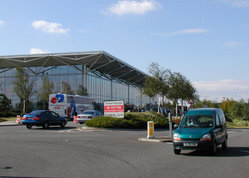 Long-standing
plans for a light rail system in the Bristol
area have not so far succeeded, and as a consequence public transport
within the city is still largely bus based. The majority of the local
bus service is operated by First_Group. The central part of the city also
has water-based routes, operated as the Bristol Ferry Boat, which provide
both leisure and commuter services on the harbour. Long-standing
plans for a light rail system in the Bristol
area have not so far succeeded, and as a consequence public transport
within the city is still largely bus based. The majority of the local
bus service is operated by First_Group. The central part of the city also
has water-based routes, operated as the Bristol Ferry Boat, which provide
both leisure and commuter services on the harbour.
The city is connected
by road on an east-west axis from London
to Wales by the M4 motorway, and on a north-southwest axis from Birmingham
to Exeter by the M5 motorway. The M32
motorway is a spur from the M4 to the city centre.
The city is also served
by its own airport (BRS), at Lulsgate, which has recently seen substantial
improvements to its runway, terminal and other facilities.
Despite being hilly,
Bristol is one of the prominent cycling
cities of England, and is
home to the national cycle campaigning group Sustrans. It has a number
of urban cycle routes, as well as links to National Cycle Network routes
to Bath and London,
to Gloucester and Wales,
and to the south-western peninsula of England.
Dialect
Many Bristolians speak
a distinctive dialect of English (known colloquially as Brizzle or Bristle).
Uniquely for an urban area of Britain, this is a rhotic dialect, in which
the r in words like car is pronounced.
The most unusual feature
of this dialect, unique to Bristol, is the Bristol
L (or Terminal L), in which an L sound is appended to words that end in
a letter a. Thus "area" becomes "areal", etc. This
may lead to confusions between expressions like area engineer and aerial
engineer which in "Bristle" sound identical. Other examples
include 'Americal' and 'Canadal', and, when unsure, the answer 'I have
no ideal'. In the same way, the Swedish Ikea is known by some as 'Ikeal'.
Another Bristolian
linguistic feature is the addition of a superfluous “to” in
questions relating to direction or orientation. For example, “Where’s
that?” would be phrased as “Where’s that to?”
and “Where’s the park?” would become “Where’s
the park to?”
Areas and Towns
The following is a
list of the areas and towns that make up the city of Bristol and its outskirts.
It includes some adjoining areas of South Gloucestershire, marked SG.
Places of Interest
- Arno's Vale
- Arnolfini
- Ashton Court
- Ashton Court
Festival
- At-Bristol
- Aviation
Heritage Museum
- Avon Gorge
- Blaise Castle
- Bristol
Cathedral
- Bristol Zoo
|
- British Empire
and Commonwealth Museum
- Cabot Tower
- City Museum
and Art Gallery
- Clifton
Cathedral
- Clifton
Down
- Clifton
Suspension Bridge
- Concorde
216
- Create Centre
|
- Cube Microplex
- Durdham
Down
- Festival
of Nature
- Floating
Harbour
- Harbour Railway
- Industrial
Museum
- International
Balloon Fiesta
- John Wesley's
Chapel
- Leigh Court
|
- Leigh Woods
- Oldbury
Court
- Old Vic
Theatre
- Red House
Museum
- Snuff Mills
- SS Great
Britain
- St Mary
Redcliffe
- Watershed
Arts Centre
|
Famous People
Many notable people
have been associated with Bristol, including musicians, engineers, scientists,
sailors and explorers.
- Isambard Kingdom
Brunel came to Bristol to build the Clifton Suspension
Bridge, and went on to be the engineer of the Great Western Railway
and the designer of the SS Great Western.
- Edmund Burke was
Member of Parliament for the city for six years from 1774. He famously
insisted that he was a Member of Parliament first, rather than a representative
of his constituents' interests.
- John Cabot set
sail from Bristol in 1497 in search
of exotic goods from the far east, but instead discovered North America.
He first sighted Newfoundland,
today a province of Canada.
- Sir Humphry Davy
was a scientist who worked in Hotwells and discovered laughing gas.
- Paul Dirac was
born in Bishopston, and made many crucial contributions to quantum mechanics
and shared the 1933 Nobel Prize for Physics 'for the discovery of new
and productive forms of atomic theory'
- Francis Greenway
was an architect and convict who was transported to Australia in 1814
and subsequently built many of the early iconic buildings of the city
of Sydney.
- John Harvey founded
the Bristol wine merchants John Harvey & Sons, and their sherry
brand Harvey's Bristol Cream has taken the name of Bristol all over
the world.
- Famous musicians
native to Bristol include Roni Size, Tricky and
Massive Attack. The group Portishead is based in the city, and the band's
name and roots come from the neighbouring town.
- Samuel Plimsoll,
'the Sailor's friend' campaigned fearlessly to make the seas safer.
He was shocked by the scandal of overloaded cargoes and successfully
fought for a compulsory loadline on ships - the Plimsoll line during
Disraeli's Conservative Government (1874-80).
- Wallace and Gromit;
heroes of the animation world and stars of the Oscar-winning 'The Wrong
Trousers', 'A Grand Day Out', 'A Close Shave' and 'The Curse of the
Were-Rabbit' were created in Bristol
by Aardman Animations.
- Svetlana Alliluyeva,
Stalin's daughter, lived briefly in Bristol
in the early 1990s.
- John Wesley founded
the very first Methodist Chapel in Bristol in
1739, which can still be visited today.
- Matt Lucas, comedy
actor and star of the highly acclaimed Little Britain television sketch
show, studied Drama at Bristol University.
- Tony Robinson
actor, trained with Bristol Old Vic and has lived in Bristol
and also been active politically there, for nearly thirty years. He
is known to television viewers for his part as 'Baldrick' in the comedy
Blackadder.
- Richard Gregory,
psychologist, resides in Bristol.
- Keith Floyd, TV
chef, ran several restaurants in Bristol, and
got his start in TV at BBC Bristol.
- Johnny Morris,
TV celebrity, resided in Bristol,
and made his television programmes at Bristol Zoo.
- James D. May,
BBC "Top Gear" presenter and "Daily Telegraph" columnist
was born in Bristol
|












 Long-standing
plans for a light rail system in the
Long-standing
plans for a light rail system in the